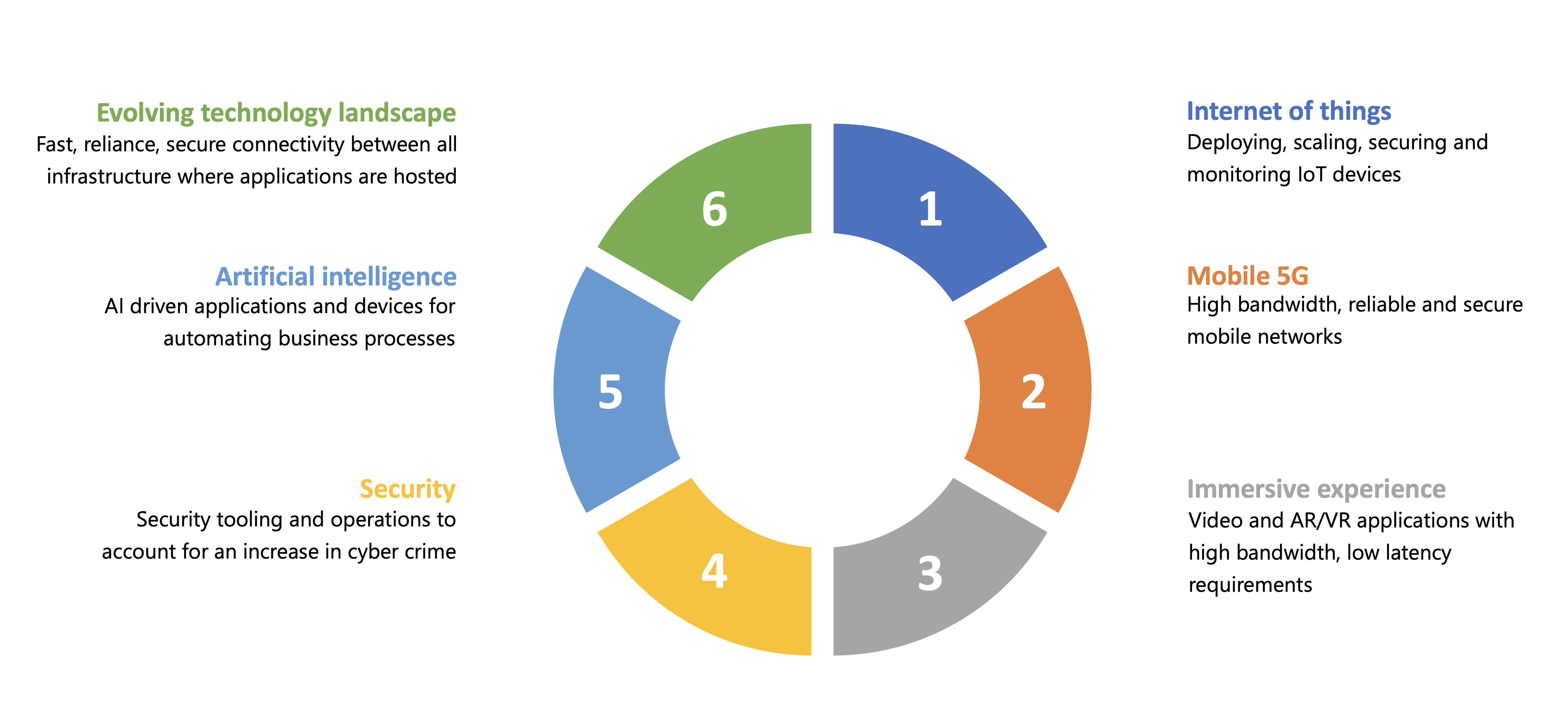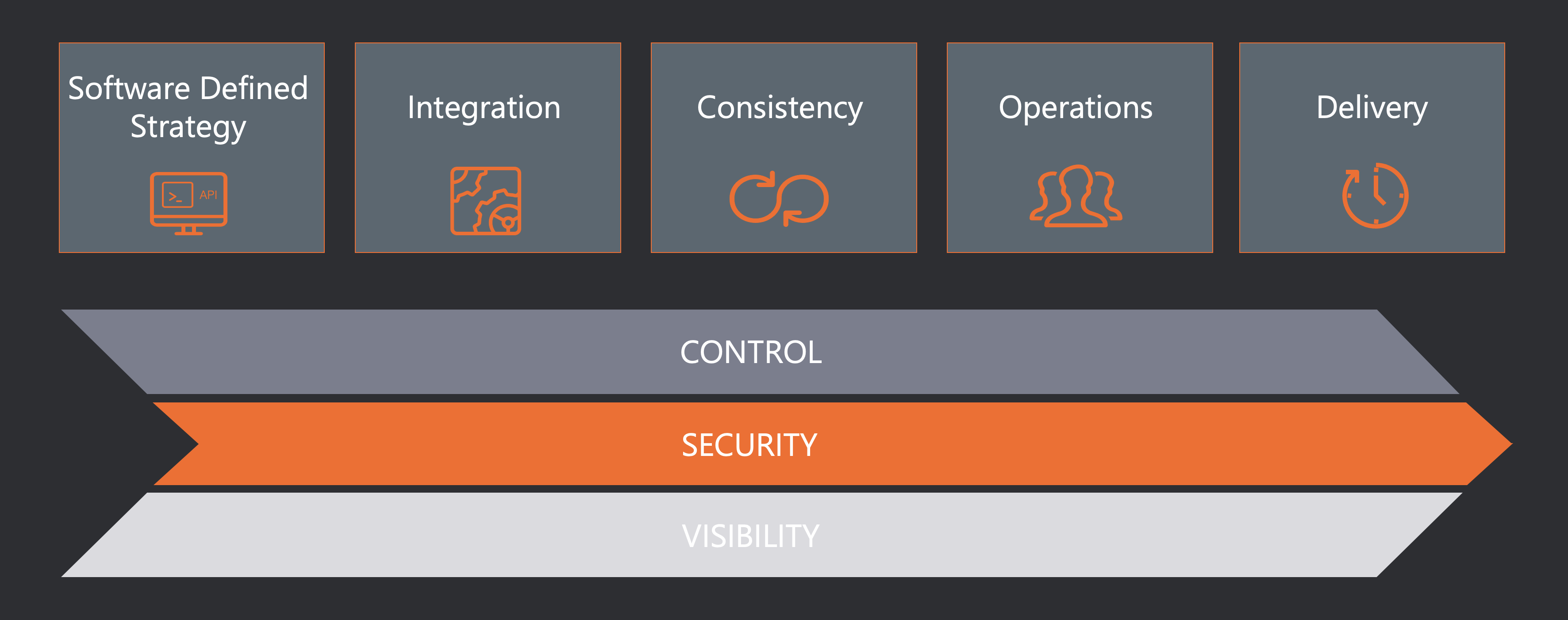SDN: Industry drivers
The adoption of SDN technologies
What is driving SDN?
In recent years, we have seen the landscape of the modern network infrastructure change dramatically for many very valid reasons. Vendors are now providing new SDN-based products to address shortcomings of existing network solutions. These new solutions offer capabilities that can accommodate the current and upcoming industry trends.
This article intends to outline the drivers for adopting SDN-related infrastructure, common problems that SDN can solve, and, more importantly, how businesses can benefit from its adoption.
What are the trends driving SDN adoption?
As every business is unique with specific objectives, the relevance of each trend varies considerably. A factor driving datacentre evolution and SDN adoption for one company may have no bearing for another. BestPath expects that every business will focus on one or more of the technology trends below.

Each of the trends will significantly impact network infrastructure in functionality, operating models, and staffing. BestPath has seen how modern network infrastructure has to adapt to meet the dynamic demands of connectivity imposed by these trends. Workloads are now provisioned on any private or public infrastructure and in any form; physical, virtual, container, or serverless.
The industry now expects modern network infrastructure to cater for:

The existing network infrastructure may not have the capability to deliver on these demands as most non-SDN-based networks struggle with either some or all of those components.
Take the example of 'multidomain.' This concept means deploying workloads onto any infrastructure regardless of the type (potentially varying vendors) or location (on-prem vs. public cloud). Many networks that do not leverage SDN struggle with the concept of multidomain. More often than not, public cloud extension will rely on manually provisioned static configuration. Companies also use bespoke, elementary scripts, but these do not always translate between different public cloud offerings.
A similar problem arises for integration between infrastructure platforms, for example, network and server infrastructure. In the use case of on-prem infrastructure, new connectivity often requires updates to both the switching and server (hosting) infrastructure. Legacy networking solutions do not transcend vendors or platforms, which means that end-to-end connectivity either needs to be manually implemented by different teams or custom automation created to account for all tasks within a workflow.
How does this impact us?
"Legacy IT challenges continue to hamper transformation efforts: 89% of business leaders say technology silos are hindering digital transformation efforts".
It's undeniable that accounting for these demands with legacy network infrastructure and operating models is a challenge. End to end connectivity takes longer to provision with mixed success. Network engineers spend longer cobbling together band-aids and temporary measures to spend more time unpicking these 'tactical solutions' when application owners don't have the required connectivity.
Network teams become stretched, overworked, and frustrated, accruing technical debt plaguing the team for years. Engineers often make compromises when they are under pressure to deliver. Therefore, the delivery is usually at the expense of supportability, standards, and security.
"That's fine. I'll get some more engineers".
Think again. Unless we make fundamental changes to the infrastructure, an increase in engineers means an increase in band-aids, higher variation of standards, and more technical debt. Something has to change.
What's needed is a platform to simplify connectivity and operations by abstracting the complexity of modern requirements. This new platform will integrate with other environments natively and offer programmability out of the box.
We should not prioritize the function of programmability over the core purpose of a switch which is to forward packets. It's of no benefit having useless switching infrastructure that we can program easily.
SDN-capable networks and the associated ecosystem of platforms and integrations can provide automated delivery of network functions to meet the demands of the business. These advanced networks can increase efficiency, streamline business processes, speed up application delivery and reduce cost.
"But I can automate my existing infrastructure".
Yes, you can, but only so far. Legacy infrastructure platforms can be automated but not as easily. The chances are that you'll be relying on CLI scraping, which will always be the weakest link in the journey. Modern SDN platforms are API-driven, offering enhanced programming features, either from customer to vendor platform or even between vendors.
APIs provided by SDN platforms allow for controllers to integrate with other platforms within the ecosystem natively, whether that be for configuration, monitoring, change management, reporting, or auditing.
According to Gartner, "Approximately 70% of datacentre networking tasks are performed manually, which increases time, cost and likelihood of errors and reduces flexibility."
"OK. So what next?"
Transformation of any datacentre is no small task, and it's never without considerable effort and a few teething issues along the way. These projects are not purely technical. There are always much broader implications on business processes, operations, and staff skillsets. To help get started and provide some insight into SDN adoption, BestPath has recorded a webinar detailing the five focus points for transforming the datacentre. The webinar offers our industry insight into areas where SDN platforms can add business value to organizations. In this webinar, we discuss the following five focus points for any datacentre transformation.

To adopt SDN platforms and move to a controlled-based model, and migrate away from legacy systems, network architects need a milestone-based plan. We need to assess and document the current position of the infrastructure. We then need to define where the network needs to be and by when. Commissioning new products without a clearly defined strategy and plan can lead to additional complexities further down the line.
So far, we have discussed the destination and the importance of creating a map to get there. However, you'll never be able to plot a journey if you don't know your existing position. Often, an external perspective can assist with evaluating the current position of the network before the evolution starts.
BestPath offers our SDN readiness assessment to help companies start their SDN journey. We conduct a review of the existing infrastructure estate and detail how transitioning to new network infrastructure can address company-specific challenges.
The SDN readiness report can act as a foundation to build upon over time.
No datacentre evolution is possible without an element of teething problems, but BestPath can keep these to a minimum.
"86% of CIOs still can't find the key talent they need, particularly in areas like cybersecurity, cloud, and data security".
Don't be in the 86%. Get in contact with BestPath today.